Geological Hazard Susceptibility Analysis and Developmental Characteristics Based on Slope Unit, Using the Xinxian County, Henan Province as an Example
Abstract
:1. Introduction
2. Overview of the Study Area
2.1. Geological Overview of the Study Area
2.2. Data Sources
3. Methods
3.1. Slope Unit Classification
3.2. Information Quantity Method
3.3. Analytic Hierarchy Process
3.4. Random Forest
4. Results
4.1. Slope Unitization
4.2. Evaluation Indicator Factor Selection
4.3. Analytic Hierarchy Process to Calculate Factor Weights
4.3.1. Analytic Hierarchy Process Method Structural Model
4.3.2. Analytic Hierarchy Process Method Weight Calculation
4.4. Evaluation of the Informativeness Model
4.4.1. Topography and Geomorphology
4.4.2. Geologic Conditions
4.4.3. Human Engineering Activities
4.4.4. Meteorology and Hydrology
4.4.5. Plant Cover Factor
4.5. Random Forest Modeling
5. Evaluation Findings and Analyses
5.1. Results of the Susceptibility Assessment
5.1.1. AHP-Information Quantity Model Susceptibility Results
5.1.2. Random Forest Model Susceptibility Results
5.1.3. Comparison
5.2. Characterization of Geohazard Development
5.2.1. Topography and Human Engineering Activities
5.2.2. Characteristics of Geological Hazard Development under the Influence of Tectonics
5.2.3. Impact of Rainfall on the Development of Geologic Hazards
5.2.4. Development Characteristics of Geologic Hazards in the Gneiss Area of Xinxian County
6. Discussion
7. Conclusions
- 1.
- An analysis utilizing the hierarchical analyzed method to assess the factors influencing geological disasters in Xinxian County identified distance from the road, average annual rainfall, distance from geological structure, and area of land use change as the primary determinants of geological disasters in the area. The increase in human engineering activities, driven by economic and social development, and the irrational excavation of natural slopes has significantly contributed to slope instability, thereby heightening the risk of geological disasters;
- 2.
- Comparative analysis between two models indicated similarities in predicting susceptibility to geological disasters within the study area. However, the AHP-informative model demonstrated superior accuracy and assessment rationality over the random forest model in evaluating susceptibility;
- 3.
- Geological hazards in Xinxian County were predominantly found in areas such as steep canyon banks and slopes, curved and concave banks of mountain rivers, watershed regions, eroded banks and slopes, and cliffs, as well as artificially steepened mountain slopes. Zones with extremely high susceptibility and a high likelihood of such hazards were primarily located along the near east–west, near north–south, northwest, and northeast fracture groups, as well as nearing Lick Tai Mountain’s back slope, the Baimashan–Xizhangdian complex slope, and the vicinity of the Baiyunshan dome;
- 4.
- The probability of geological hazards, including landslides, avalanches, and mudslides, increased with the intensity and cumulative amount of precipitation. The stability of slopes in the surveyed area was compromised to varying extents by precipitation, with rainfall being a key triggering factor for these hazards;
- 5.
- The gneiss rock group exposed in the Xinxian area had a large area, and many disaster points throughout the group were distributed across all of the towns and villages in the county. Because the strength of gneiss changes greatly under the action of weathering, and different weathering degrees result in vastly different effects, the properties of rock and soil mass with different weathering degrees was shown to play a decisive role in slope stability.
Author Contributions
Funding
Institutional Review Board Statement
Informed Consent Statement
Data Availability Statement
Acknowledgments
Conflicts of Interest
References
- Zhang, W.G.; Liu, S.L.; Wang, L.Q.; Samui, P.; Chwala, M.; He, Y.W. Landslide Susceptibility Research Combining Qualitative Analysis and Quantitative Evaluation: A Case Study of Yunyang County in Chongqing, China. Forests 2022, 13, 1055. [Google Scholar] [CrossRef]
- Derbyshire, E. Geological hazards in loess terrain, with particular reference to the loess regions of China. Earth-Sci. Rev. 2001, 54, 231–260. [Google Scholar] [CrossRef]
- Xiaodong, Z.; Xiangnan, L.I.U.; Zhipeng, Z.; Wenzhong, W. Comparative study of geological hazards susceptibility assessment: Constraints from the information value+ logistic regression model and the CF+ logistic regression model. Geoscience 2018, 32, 602. [Google Scholar]
- Ai-di, H.; Hui-xia, Z.; Li, Z.; Hua, L.; Ming, H. A sampled method of classification of susceptibility evaluation unit for geological hazards based on GIS. Appl. Math. Inf. Sci. 2012, 6, 19–23. [Google Scholar]
- Chen, G.; Li, S. Research on location fusion of spatial geological disaster based on fuzzy SVM. Comput. Commun. 2020, 153, 538–544. [Google Scholar] [CrossRef]
- Ma, Z.; Mei, G. Deep learning for geological hazards analysis: Data, models, applications, and opportunities. Earth-Sci. Rev. 2021, 223, 103858. [Google Scholar] [CrossRef]
- Tan, Q.; Huang, Y.; Hu, J.; Zhou, P.; Hu, J. Application of artificial neural network model based on GIS in geological hazard zoning. Neural Comput. Appl. 2021, 33, 591–602. [Google Scholar] [CrossRef]
- Zhang, S.; Tan, S.; Geng, H.; Li, R.; Sun, Y.; Li, J. Evaluation of Geological Hazard Risk in Yiliang County, Yunnan Province, Using Combined Assignment Method. Sustainability 2023, 15, 13978. [Google Scholar] [CrossRef]
- Fan, Z.; Gou, X.; Qin, M.; Fan, Q.; Yu, J.; Zhao, J. Information and Logistic Regression Models Based Coupl-Ing Analysis for Susceptibility of Geological Hazards. J. Eng. Geol. 2018, 26, 340–347. [Google Scholar]
- Lyu, H.M.; Shen, J.S.; Arulrajah, A. Assessment of geohazards and preventative countermeasures using AHP incorporated with GIS in Lanzhou, China. Sustainability 2018, 10, 304. [Google Scholar] [CrossRef]
- Hongtao, N. Smart safety early warning model of landslide geological hazard based on BP neural network. Saf. Sci. 2020, 123, 104572. [Google Scholar] [CrossRef]
- Wu, X.; Song, Y.; Chen, W.; Kang, G.; Qu, R.; Wang, Z.; Lv, P.; Chen, H. Analysis of Geological Hazard Susceptibility of Landslides in Muli County Based on Random Forest Algorithm. Sustainability 2023, 15, 4328. [Google Scholar] [CrossRef]
- Zhao, J.; Zhang, Q.; Wang, D.; Wu, W.; Yuan, R. Machine learning-based evaluation of susceptibility to geological hazards in the Hengduan mountains region, China. Int. J. Disaster Risk Sci. 2022, 13, 305–316. [Google Scholar] [CrossRef]
- Shano, L.; Raghuvanshi, T.K.; Meten, M. Landslide susceptibility evaluation and hazard zonation techniques—A review. Geoenviron. Disasters 2020, 7, 18. [Google Scholar] [CrossRef]
- Xingli, J.; Qingmiao, D.; Hongzhi, Y. Susceptibility zoning of karst geological hazards using machine learning and cloud model. Clust. Comput. 2019, 22, 8051–8058. [Google Scholar] [CrossRef]
- Zhang, S.; Tan, S.; Liu, L.; Ding, D.; Sun, Y.; Li, J. Slope Rock and Soil Mass Movement Geological Hazards Susceptibility Evaluation Using Information Quantity, Deterministic Coefficient, and Logistic Regression Models and Their Comparison at Xuanwei, China. Sustainability 2023, 15, 10466. [Google Scholar] [CrossRef]
- Panchal, S.; Shrivastava, A.K. Landslide hazard assessment using analytic hierarchy process (AHP): A case study of National Highway 5 in India. Ain Shams Eng. J. 2022, 13, 101626. [Google Scholar] [CrossRef]
- Wang, J.; Zhu, S.; Luo, X.; Chen, G.; Xu, Z.; Liu, X.; Li, Y. Refined micro-scale geological disaster susceptibility evaluation based on UAV tilt photography data and weighted certainty factor method in Mountainous Area. Ecotoxicol. Environ. Saf. 2020, 189, 110005. [Google Scholar] [CrossRef] [PubMed]
- Wang, X.; Zhang, C.; Wang, C.; Liu, G.; Wang, H. GIS-based for prediction and prevention of environmental geological disaster susceptibility: From a perspective of sustainable development. Ecotoxicol. Environ. Saf. 2021, 226, 112881. [Google Scholar] [CrossRef]
- Ji, J.; Cui, H.; Zhang, T.; Song, J.; Gao, Y. A GIS-based tool for probabilistic physical modelling and prediction of landslides: GIS-FORM landslide susceptibility analysis in seismic areas. Landslides 2022, 19, 2213–2231. [Google Scholar] [CrossRef]
- Yanting, H.; Yonggang, G. Risk assessment of rain-induced debris flow in the lower reaches of Yajiang River based on GIS and CF coupling models. Open Geosci. 2023, 15, 20220472. [Google Scholar] [CrossRef]
- Chen, J.; Gao, H.; Han, L.; Yu, R.; Mei, G. Susceptibility Analysis of Glacier Debris Flow Based on Remote Sensing Imagery and Deep Learning: A Case Study along the G318 Linzhi Section. Sensors 2023, 23, 6608. [Google Scholar] [CrossRef] [PubMed]
- Yang, F.; Men, X.; Liu, Y.; Mao, H.; Wang, Y.; Wang, L.; Zhou, X.; Niu, C.; Xie, X. Estimation of Landslide and Mudslide Susceptibility with Multi-Modal Remote Sensing Data and Semantics: The Case of Yunnan Mountain Area. Land 2023, 12, 1949. [Google Scholar] [CrossRef]
- Li, B.; Wang, N.; Chen, J. GIS-based landslide susceptibility mapping using information, frequency ratio, and artificial neural network methods in Qinghai Province, Northwestern China. Adv. Civ. Eng. 2021, 2021, 4758062. [Google Scholar] [CrossRef]
- Li, M.; Li, L.; Lai, Y.; He, L.; He, Z.; Wang, Z. Geological Hazard Susceptibility Analysis Based on RF, SVM, and NB Models, Using the Puge Section of the Zemu River Valley as an Example. Sustainability 2023, 15, 11228. [Google Scholar] [CrossRef]
- Li, R.; Tan, S.; Zhang, M.; Zhang, S.; Wang, H.; Zhu, L. Geological Disaster Susceptibility Evaluation Using a Random Forest Empowerment Information Quantity Model. Sustainability 2024, 16, 765. [Google Scholar] [CrossRef]
- Chowdhuri, I.; Pal, S.C.; Chakrabortty, R.; Malik, S.; Das, B.; Roy, P. Torrential rainfall-induced landslide susceptibility assessment using machine learning and statistical methods of eastern Himalaya. Nat. Hazards 2021, 107, 697–722. [Google Scholar] [CrossRef]
- Sujatha, E.R.; Sridhar, V. Landslide susceptibility analysis: A logistic regression model case study in Coonoor, India. Hydrology 2021, 8, 41. [Google Scholar] [CrossRef]
- Wang, F.; Xu, P.; Wang, C.; Wang, N.; Jiang, N. Application of a GIS-based slope unit method for landslide susceptibility mapping along the Longzi River, Southeastern Tibetan Plateau, China. ISPRS Int. J. Geo-Inf. 2017, 6, 172. [Google Scholar] [CrossRef]
- Tanyas, H.; Rossi, M.; Alvioli, M.; van Westen, C.J.; Marchesini, I. A global slope unit-based method for the near real-time prediction of earthquake-induced landslides. Geomorphology 2019, 327, 126–146. [Google Scholar] [CrossRef]
- Gao, R.; Wang, C.; Liang, Z.; Han, S.; Li, B. A research on susceptibility mapping of multiple geological hazards in Yanzi River Basin, China. ISPRS Int. J. Geo-Inf. 2021, 10, 218. [Google Scholar] [CrossRef]
- Ke, K.; Zhang, Y.; Zhang, J.; Chen, Y.; Wu, C.; Nie, Z.; Wu, J. Risk Assessment of Earthquake–Landslide Hazard Chain Based on CF-SVM and Newmark Model—Using Changbai Mountain as an Example. Land 2023, 12, 696. [Google Scholar] [CrossRef]
- Wang, W.D.; Li, J.; Han, Z. Comprehensive assessment of geological hazard safety along railway engineering using a novel method: A case study of the Sichuan-Tibet railway, China. Geomat. Nat. Hazards Risk 2020, 11, 1–21. [Google Scholar] [CrossRef]
- Tan, Y.; Guo, D.; Xu, B. A geospatial information quantity model for regional landslide risk assessment. Nat. Hazards 2015, 79, 1385–1398. [Google Scholar] [CrossRef]
- Tan, Q.; Bai, M.; Zhou, P.; Hu, J.; Qin, X. Geological hazard risk assessment of line landslide based on remotely sensed data and GIS. Measurement 2021, 169, 108370. [Google Scholar] [CrossRef]
- Yang, F.; Jiang, Z.; Ren, J.; Lv, J. Monitoring, prediction, and evaluation of mountain geological hazards based on InSAR technology. Sci. Program. 2022, 2022, 2227049. [Google Scholar] [CrossRef]
- Ghanavati, E. Landslide hazard zonation by using AHP (analytical hierarchy process) model in GIS (geographic information system) environment (case study: Kordan watershed). Int. J. Sci. High Technol. 2016, 2, 24–39. [Google Scholar]
- Lin, J.; Chen, W.; Qi, X.; Hou, H. Risk assessment and its influencing factors analysis of geological hazards in typical mountain environment. J. Clean. Prod. 2021, 309, 127077. [Google Scholar] [CrossRef]
- Stefanidis, S.; Stathis, D. Assessment of flood hazard based on natural and anthropogenic factors using analytic hierarchy process (AHP). Nat. Hazards 2013, 68, 569–585. [Google Scholar] [CrossRef]
- Zhang, Y.; Wu, W.; Qin, Y.; Lin, Z.; Zhang, G.; Chen, R.; Song, Y.; Lang, T.; Zhou, X.; Hangfu, W.; et al. Mapping landslide hazard risk using random forest algorithm in Guixi, Jiangxi, China. ISPRS Int. J. Geo-Inf. 2020, 9, 695. [Google Scholar] [CrossRef]
- Wang, Z.; Lai, C.; Chen, X.; Yang, B.; Zhao, S.; Bai, X. Flood hazard risk assessment model based on random forest. J. Hydrol. 2015, 527, 1130–1141. [Google Scholar] [CrossRef]
- Liu, W.; Zhang, Y.; Liang, Y.; Sun, P.; Li, Y.; Su, X.; Wang, A.; Meng, X. Landslide risk assessment using a combined approach based on InSAR and random forest. Remote Sens. 2022, 14, 2131. [Google Scholar] [CrossRef]
- Abu El-Magd, S.A.; Ali, S.A.; Pham, Q.B. Spatial modeling and susceptibility zonation of landslides using random forest, naïve bayes and K-nearest neighbor in a complicated terrain. Earth Sci. Inform. 2021, 14, 1227–1243. [Google Scholar] [CrossRef]
- Choubin, B.; Mosavi, A.; Alamdarloo, E.H.; Hosseini, F.S.; Shamshirband, S.; Dashtekian, K.; Ghamisi, P. Earth fissure hazard prediction using machine learning models. Environ. Res. 2019, 179, 108770. [Google Scholar] [CrossRef] [PubMed]
- Rahmati, O.; Golkarian, A.; Biggs, T.; Keesstra, S.; Mohammadi, F.; Daliakopoulos, I.N. Land subsidence hazard modeling: Machine learning to identify predictors and the role of human activities. J. Environ. Manag. 2019, 236, 466–480. [Google Scholar] [CrossRef] [PubMed]
- Yousefi, S.; Pourghasemi, H.R.; Emami, S.N.; Pouyan, S.; Eskandari, S.; Tiefenbacher, J.P. A machine learning framework for multi-hazards modeling and mapping in a mountainous area. Sci. Rep. 2020, 10, 12144. [Google Scholar] [CrossRef] [PubMed]
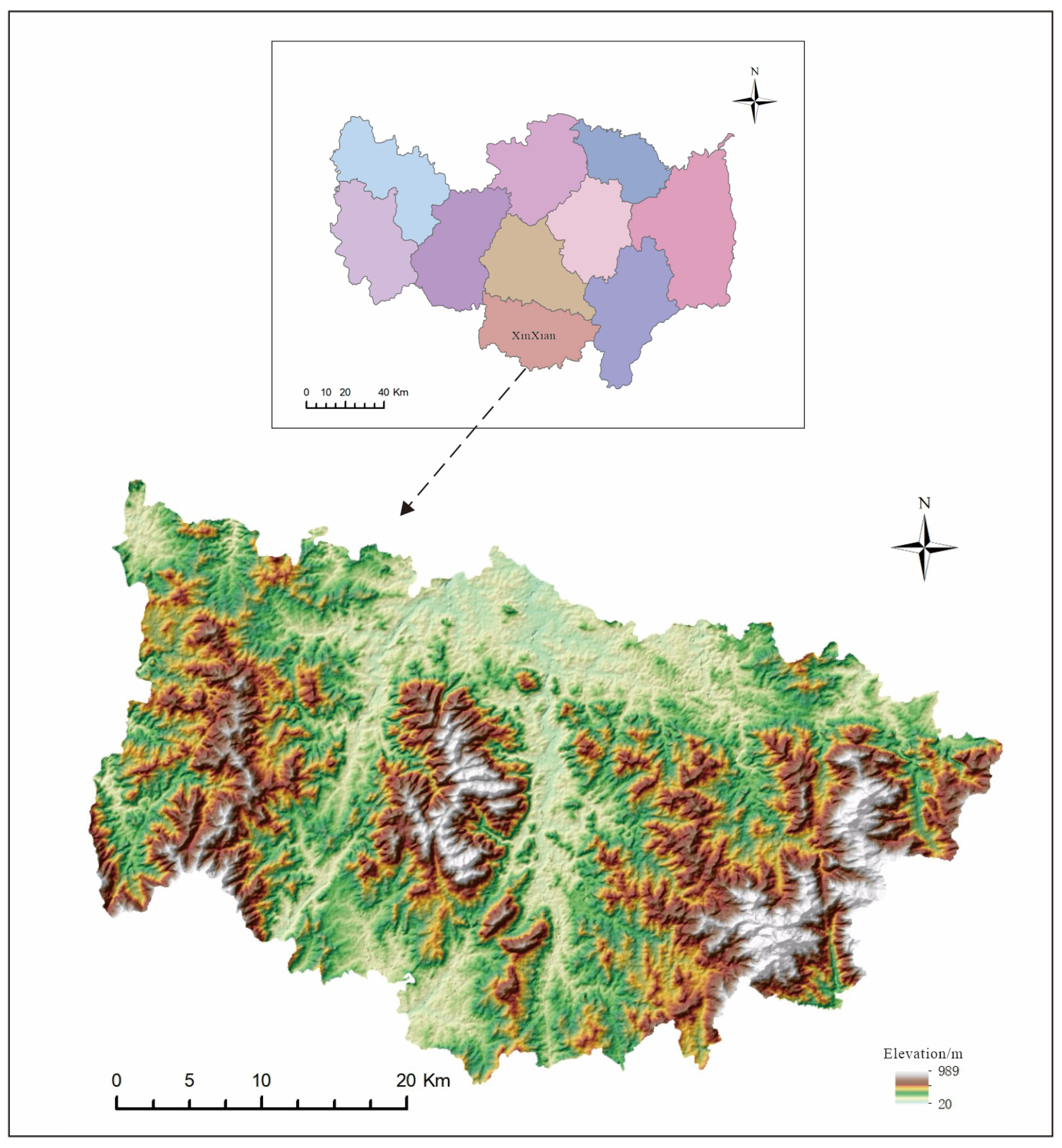

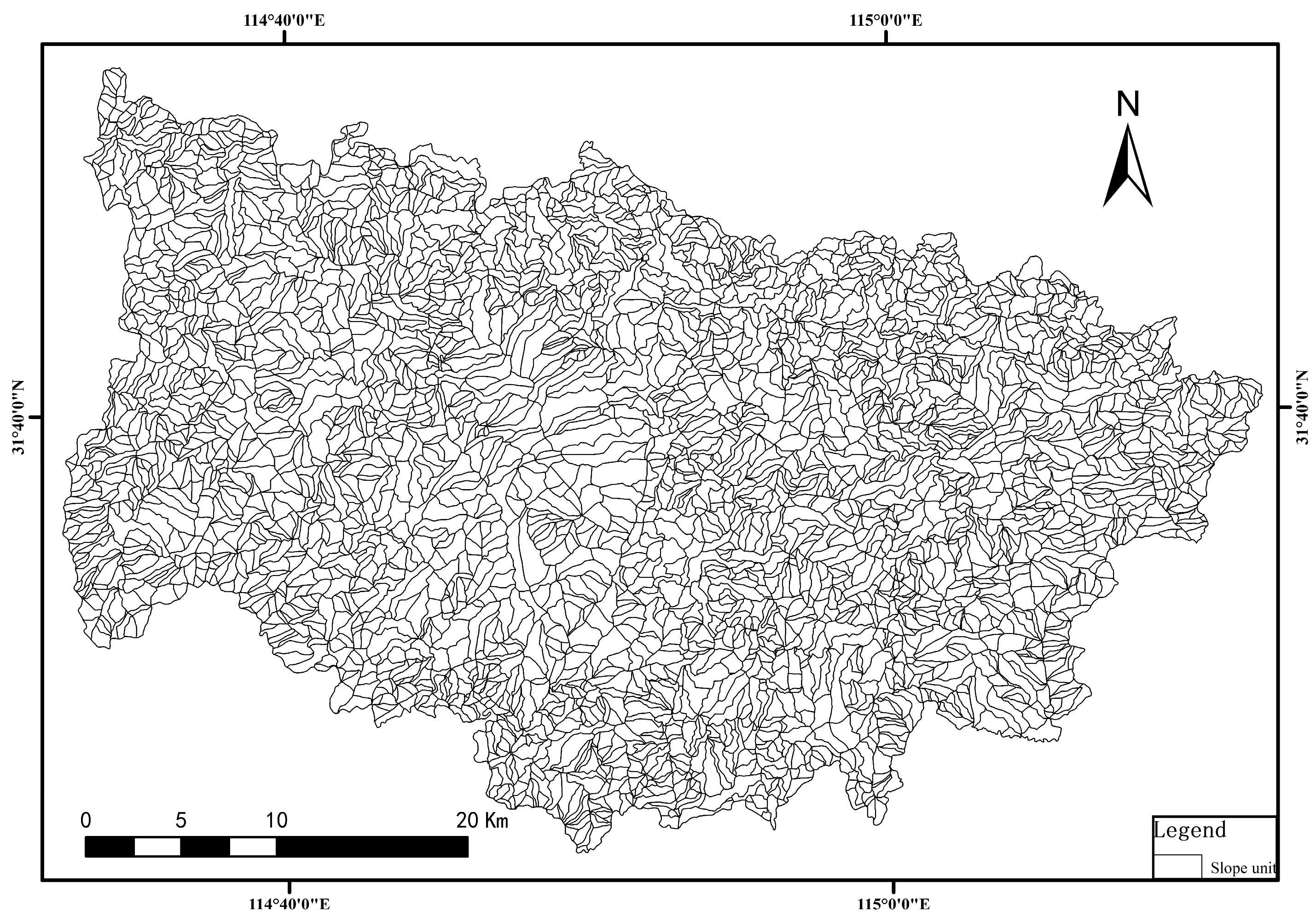
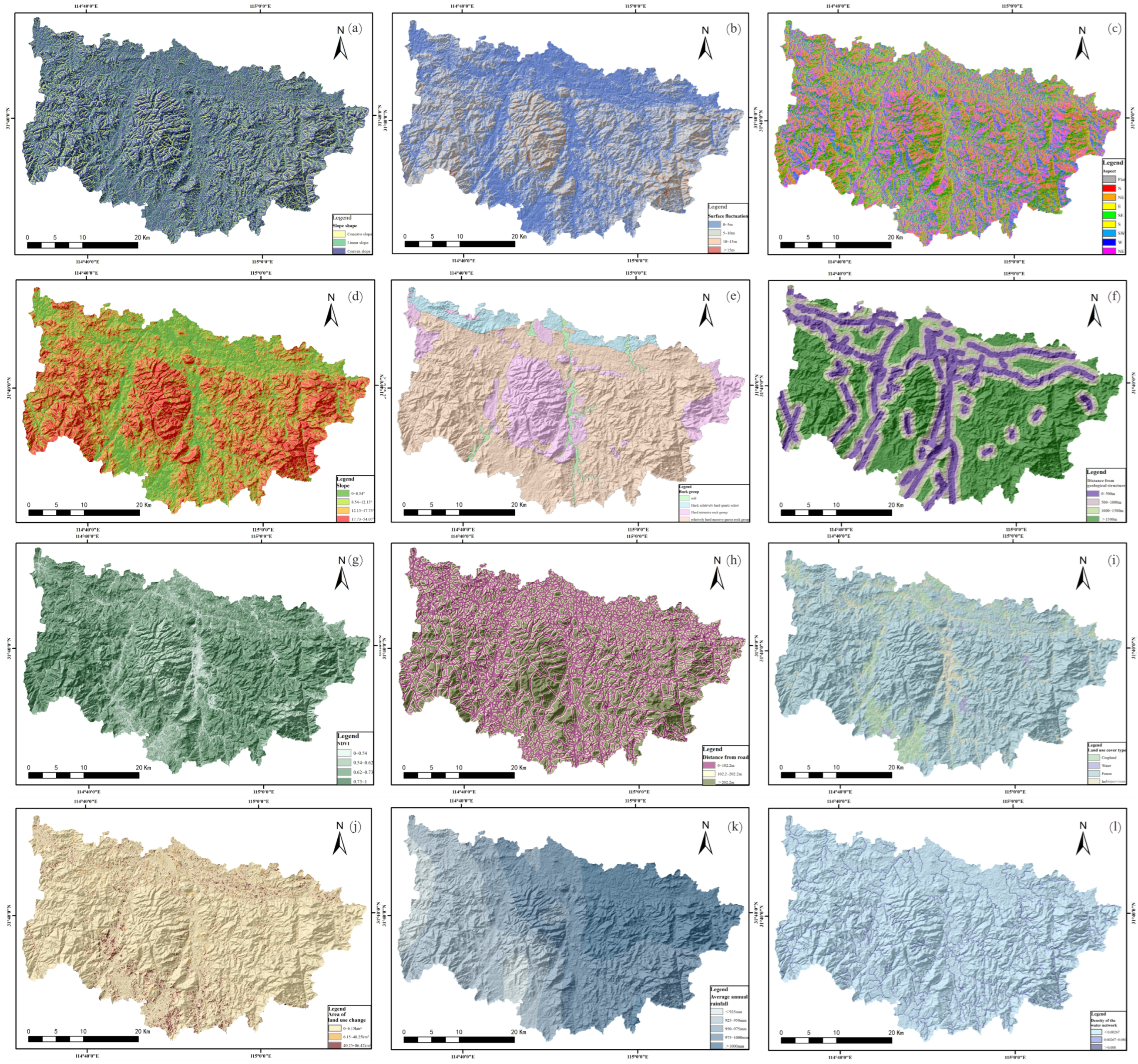



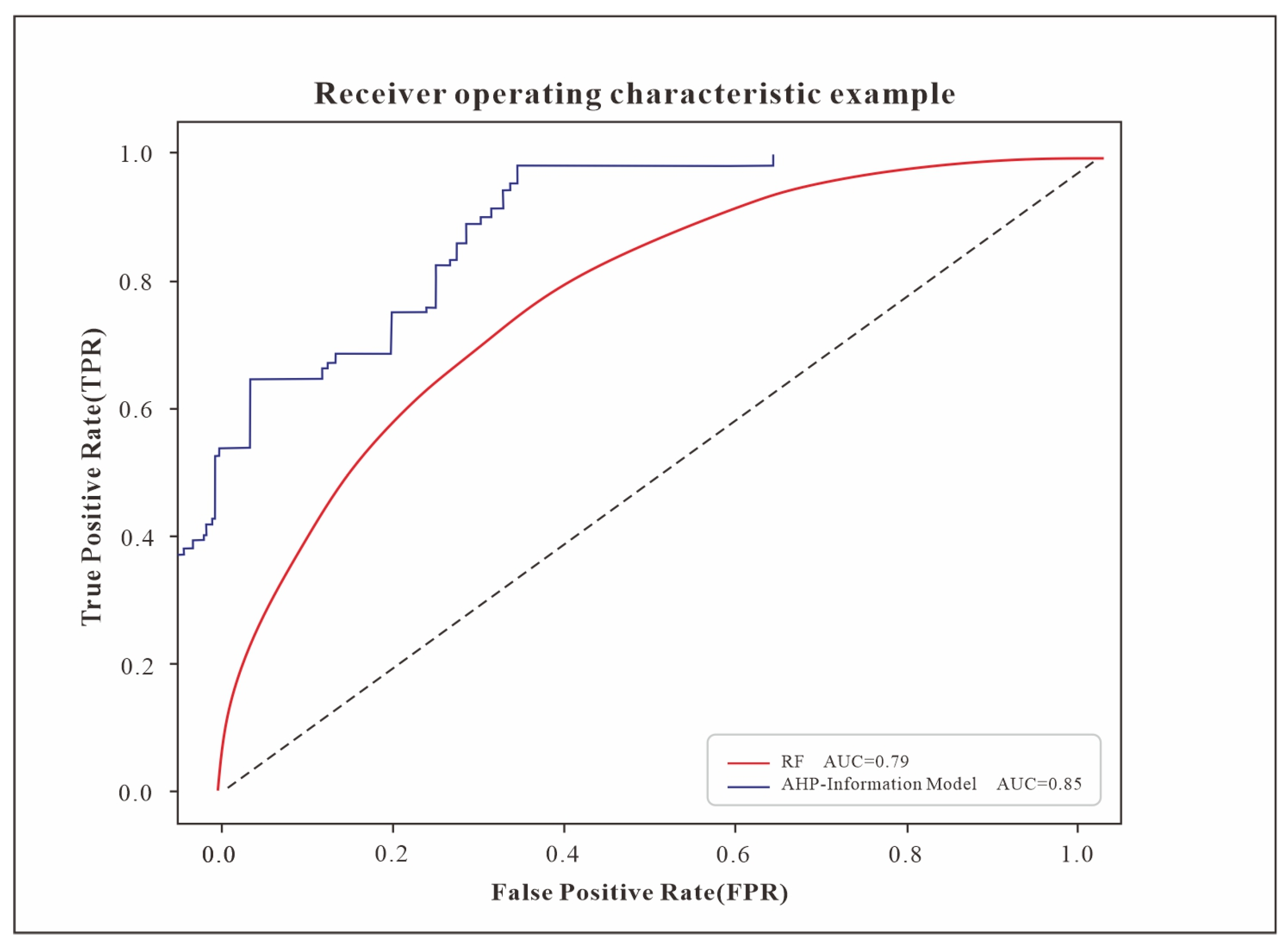
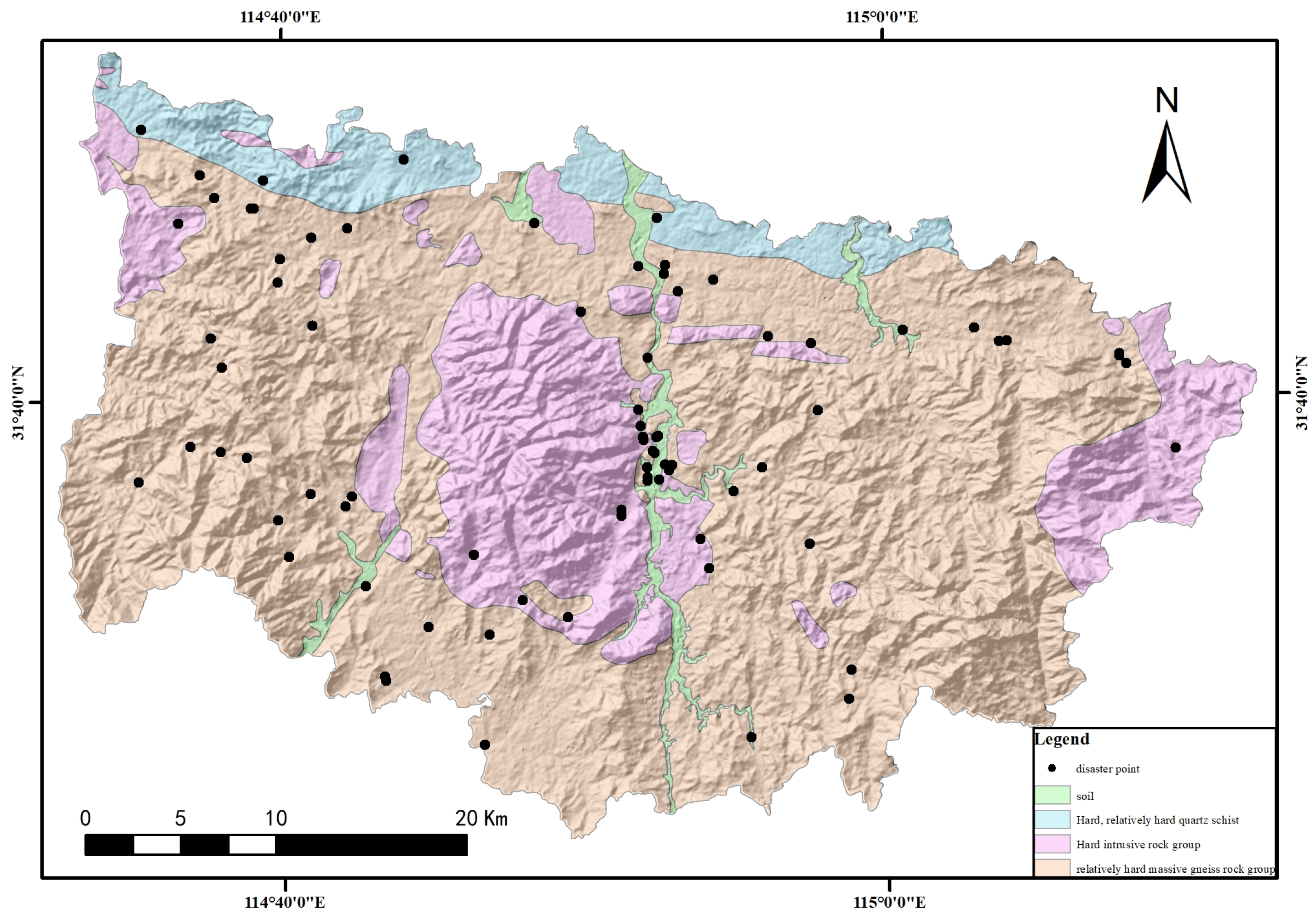
| Factors | Types | Sources |
|---|---|---|
| Elevation | Raster data (12.5 m) | Calculation and extraction of GDEMV3 12.5 M based on ArcGIS 10.8 software |
| Slope | Raster data (12.5 m) | |
| Aspect | Raster data (12.5 m) | |
| Slope shape | Raster data (12.5 m) | |
| Topographic relief | Raster data (12.5 m) | |
| Distance from geological structure | Vector data | Extracted using ArcGIS 10.8 software |
| Rock group | Vector data | Field data on geological hazards |
| Distance from road | Vector data | Extracted using ArcGIS 10.8 software |
| Land use cover type | Raster data (10 m) | www.globallandcover.com (9 March 2024) |
| Area of land use change | Raster data (10 m) | 10 M land use treatments were obtained using ArcGIS 10.8 software. |
| NDVI | Raster data (12.5 m) | Landsat 8 OLI_TIRS Satellite data, http://www.gscloud.cn/ (9 March 2024) |
| Average annual rainfall | Raster data (12.5 m) | http://www.geodata.cn (9 March 2024) |
| River network density | Raster data (12.5 m) |
| Object Layer | Factor Layer | Index Layer | w |
|---|---|---|---|
| Geologic hazard susceptibility | Topography and geomorphology (U1) | Topographic relief (U11) | 0.0181 |
| Slope aspect (U12) | 0.0155 | ||
| Gradient (U13) | 0.0217 | ||
| Slope shape (U14) | 0.0091 | ||
| Geologic conditions (U2) | Rock group (U21) | 0.0627 | |
| Distance from geological structure (U22) | 0.1254 | ||
| Human engineering activities (U3) | Distance from road (U31) | 0.2838 | |
| Area of land use change (U32) | 0.0946 | ||
| Meteorology and hydrology (U4) | Annual average precipitation (U41) | 0.1726 | |
| River network density (U42) | 0.0575 | ||
| Plant cover factor (U5) | NDVI (U51) | 0.0463 | |
| Land use (U52) | 0.0926 |
| Evaluation Factor | Classification | Disaster Points | Volume of Information |
|---|---|---|---|
| Slope shape | Concave slope | 11 | −0.31 |
| Linear slope | 18 | −0.10 | |
| Convex slope | 50 | 0.12 | |
| Rock group | Soil | 9 | 1.59 |
| Hard and relatively hard quartz schist | 4 | −0.21 | |
| Hard intrusive rock group Helatively hard massive | 53 | −0.04 | |
| gneiss rock group | 13 | −0.27 | |
| Topographic relief | 0~5 | 26 | −0.39 |
| 5~10 | 43 | 0.14 | |
| 10~15 | 9 | 0.69 | |
| >15 | 3 | 2.13 | |
| Distance from geological structure | 0~500 | 27 | 0.85 |
| 500~1000 | 11 | 0.02 | |
| 1000~1500 | 7 | −0.28 | |
| >1500 | 34 | −0.33 | |
| Slope | 0~8.54 | 17 | −0.21 |
| 8.54~12.13 | 24 | 0.64 | |
| 12.13~17.73 | 27 | 0.36 | |
| 17.73~54.07 | 11 | −0.88 | |
| NDVI | 0~0.54 | 26 | 1.53 |
| 0.54~0.62 | 18 | 0.62 | |
| 0.62~0.73 | 26 | −0.31 | |
| 0.73~1 | 9 | −1.15 | |
| Distance from road | 0~102.2 | 56 | 0.45 |
| 102.2~202.2 | 21 | 0.03 | |
| >202.2 | 2 | −2.44 | |
| Aspect | Flat | 2 | 0.02 |
| N | 3 | −1.05 | |
| NE | 8 | −0.13 | |
| E | 10 | 0.03 | |
| SE | 12 | 0.16 | |
| S | 9 | −0.01 | |
| SW | 12 | 0.24 | |
| W | 15 | 0.40 | |
| NE | 8 | −0.30 | |
| Land use cover type | Water | 0 | 0.00 |
| Forest | 27 | −0.89 | |
| Cropland | 1 | −1.78 | |
| Impervious | 51 | 2.09 | |
| Area of land use change | 0~6.1533 | 66 | −0.09 |
| 6.1533~40.248901 | 7 | 1.22 | |
| 40.248901~86.414398 | 6 | 0.31 | |
| Average annual rainfall | <925 | 4 | −0.25 |
| 925~950 | 28 | 0.28 | |
| 950~975 | 3 | −1.09 | |
| 975~1000 | 29 | 0.16 | |
| >1000 | 15 | −0.24 | |
| River network density | <0.00267 | 66 | −0.08 |
| 0.00267~0.080 | 5 | 0.64 | |
| >0.008 | 8 | 0.51 |
| Types | Parameters |
|---|---|
| N estimators | 1000 |
| Max depth | 5 |
| Criterion | Gini |
| Geologic Hazard Susceptibility Zoning | Number of Disasters | Number of Slope Units | Slope Unit Area/km2 | Area Proportion/% | Density of Disaster Sites/pcs/km2 |
|---|---|---|---|---|---|
| Very High susceptibility area | 33 | 678 | 193.15 | 12.43% | 0.1709 |
| High susceptibility area | 24 | 945 | 366.02 | 23.56% | 0.0656 |
| Moderate susceptibility area | 15 | 1467 | 607.32 | 39.09% | 0.0247 |
| Low susceptibility area | 7 | 946 | 386.97 | 24.91% | 0.0181 |
| Geologic Hazard Susceptibility Zoning | Number of Disasters | Number of Slope Units | Slope Unit Area/km2 | Area Proportion/% | Density of Disaster Sites/pcs/km2 |
|---|---|---|---|---|---|
| Very High susceptibility area | 30 | 598 | 194.45 | 12.52% | 0.1543 |
| High susceptibility area | 21 | 966 | 336.39 | 21.65% | 0.0624 |
| Moderate susceptibility area | 19 | 1560 | 635.34 | 40.90% | 0.0299 |
| Low susceptibility area | 9 | 912 | 387.28 | 24.93% | 0.0232 |
| Rock Group | Number of Geologic Hazard Sites |
|---|---|
| Soil | 9 |
| Hard, relatively hard quartz schist | 4 |
| Hard intrusive rock group | 53 |
| Helatively hard massive gneiss rock group | 13 |
Disclaimer/Publisher’s Note: The statements, opinions and data contained in all publications are solely those of the individual author(s) and contributor(s) and not of MDPI and/or the editor(s). MDPI and/or the editor(s) disclaim responsibility for any injury to people or property resulting from any ideas, methods, instructions or products referred to in the content. |
© 2024 by the authors. Licensee MDPI, Basel, Switzerland. This article is an open access article distributed under the terms and conditions of the Creative Commons Attribution (CC BY) license (https://creativecommons.org/licenses/by/4.0/).
Share and Cite
Yang, W.; Niu, R.; Si, R.; Li, J. Geological Hazard Susceptibility Analysis and Developmental Characteristics Based on Slope Unit, Using the Xinxian County, Henan Province as an Example. Sensors 2024, 24, 2457. https://doi.org/10.3390/s24082457
Yang W, Niu R, Si R, Li J. Geological Hazard Susceptibility Analysis and Developmental Characteristics Based on Slope Unit, Using the Xinxian County, Henan Province as an Example. Sensors. 2024; 24(8):2457. https://doi.org/10.3390/s24082457
Chicago/Turabian StyleYang, Wentao, Ruiqing Niu, Rongjun Si, and Jun Li. 2024. "Geological Hazard Susceptibility Analysis and Developmental Characteristics Based on Slope Unit, Using the Xinxian County, Henan Province as an Example" Sensors 24, no. 8: 2457. https://doi.org/10.3390/s24082457




